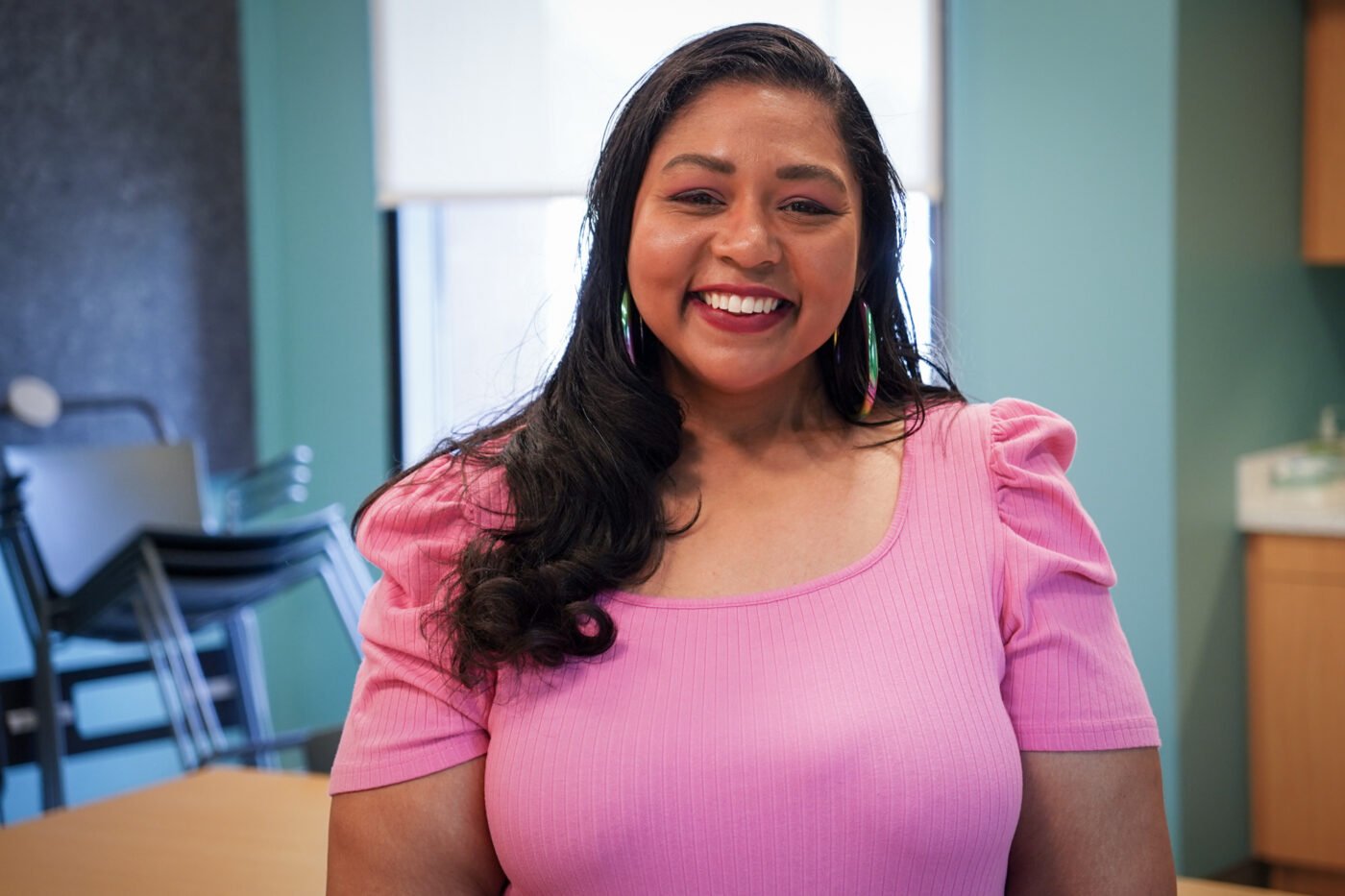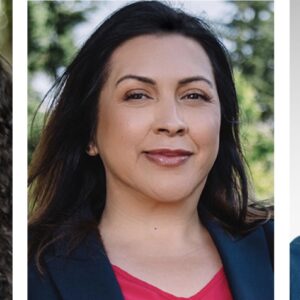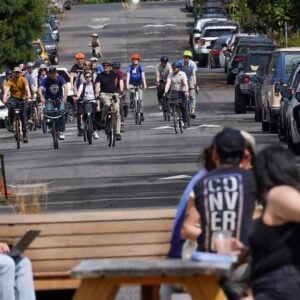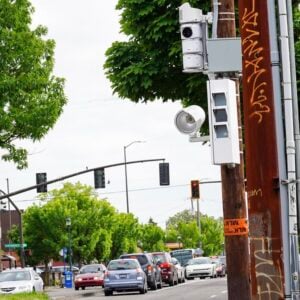
Portland City Councilor Candace Avalos says a new City of Portland governing body with strong police oversight needs representation from transportation advocates. And with applications to serve on the Community Board for Police Accountability due before April 15th, Councilor Avalos believes now is a golden opportunity to make sure Portland’s definition of public safety includes safe streets.
On Friday I sat down with Avalos in a conference room in Midland Library to talk about policing and transportation. Avalos, who represents an area east of I-205 including Lents in southeast and the Portland Airport, is a first time member of city council, but she’s no stranger to local politics. She was chair of the Citizen Review Committee, where she served for six years and became a well-known advocate for police accountability.
The impetus for our conversation was the CBPA, a new, high-profile venue for oversight of the Portland Police Bureau. The 21-member governing body will have its own budget, will hire its own investigators, and will issue binding decisions regarding police practices, policies, and directives with a primary focus on community concerns.
It’s crucial that this new CBPA have at least one member who understands how transportation issues relate to public safety and policing. It’s my hope my interview with Councilor Avalos encourages someone in our audience to apply for one of the positions.
Listen to our conversation in the player above or wherever you get your podcasts. You can also read an edited version of the interview below.
How do you connect the dots between transportation and policing?
“When we think about policing and public safety, we tend to limit it to things like crime or gun violence and things like that. But as we know, in east Portland in particular, which has 28 out of 30 high crash corridors, transportation safety is a huge part of public safety.
As we’re making decisions about improving [transportation] it needs to include the fact that many of our communities are dying needlessly on the streets and are being hit by cars. And in east Portland, it’s particularly harsh.”
How do you feel about using automated cameras to enforce traffic laws?
“I am open to the discussion. I think that it’s definitely in a tool that we should explore… In general, about traffic cameras, I feel that they have good intentions. I worry about where we decide to put them, and how that affects certain populations.
[On the campaign trail] I heard a lot from east Portlanders that they felt that the streets were just kind of reckless, that people were driving very quickly. I had a lot of complaints when I was knocking on doors about people driving quickly through the neighborhoods too, not just on the main streets. And so, yeah, I feel like I’m open to [speed cameras] and concerned about what the impacts might be disproportionately on a community that you know is already facing so much hardship.”
How would you characterize the current relationship between police and the community?
“The temperatures are down, and I think in all areas it’s less politically-charged that it was, for sure. That definitely doesn’t mean that people aren’t paying attention, but I think the energy is a lot less…
I think that just having a leader [new (since the George Floyd protests) Police Chief Bob Day] that has earned the trust of many different aspects, I think has really shifted the dynamic.
I really do like Chief Day. I think he’s personable, I think he’s reasonable. When I have discussions with him, I see him really trying to come to a decision that is fair. And I think that has shifted the relationship, for sure…
I think right now, the police union sees their relationship with the city is, like, tenuous, right? Because they don’t necessarily have all of the more overt champions that they have tended to have on the council in the past.
… I wouldn’t say we’re in a positive place, but I would say a neutral place, with community.”
Why should transportation reform advocates and people who care about street safety, be paying attention to the Community Body for Police Accountability?
“I think it’s important for people to engage in this new process because we have created a really robust, really unique in the country, type of board, as far as the powers that we gave it.”
How is the CBPA more powerful than what came before?
“That old system has a lot of flaws. I think the main flaw there was the lack of true teeth in that process and everything really was just deference to police… It’s a system that does not have any true accountability because everything was so deferential to police in the first place. So that is the biggest change in this new police board, is that the people on the board actually have a lot more control. The standard of evidence is different.
… So I’m hoping that this new board, with its new teeth, will be able to usher in a new awareness about what we should expect from our police, and what does it mean to hold them accountable?”
What element of the CBPA are you most excited about?
“I’m excited that this board will actually have teeth… We wrote it in [to the bylaws] that the city has to respond to recommendations… We specifically did that so that when community does come and say, ‘Hey, we’re having these issues with these, you know, these police chases [for example], and it’s affecting the streets in this way,’ they’re going to have to respond by charter. So that’s really exciting to me, that the charter really instituted strong protections for the people’s voice in the process.”
With protest season ramping up, how confident are you that the Portland Police have learned lessons from past years and will change how they respond?
“I am very concerned, and I want to see police’s response to the fact that traffic, traffic attacks, car attacks, are on the rise. I was just having dinner with a friend who’s not plugged into politics, and she brought up to me how scared she was that this is the new norm — that protesters on the streets are getting run over…
I think that is a really important transportation justice issue, because I see that is an important place for police to intervene, in my opinion, protecting people’s rights to protest and ensuring that they’re not going to have somebody try to violently attack them with a car. So I would, I would like to see them increase their strategy for how to protect people.”
What can transportation advocates do to get street safety on the radar of the police in a bigger way?
“I think helping us reshape the narrative, like using these advocates to tell these stories and show how they fit into a larger public safety concern. I think that could be a really good place for advocates to start, because it’s not just police not making that connection. It’s also the city and it’s also the average Portlander. So how do we elevate that issue and show its relevance to public safety?”
Do you think now is a good time for transportation advocates to put police accountability on their radar and get involved with this?
“I do. I really think it’s important that transportation advocates elevate the dangers that we face just navigating our streets as non-car users, and that that needs to be again, part of the strategy for how to protect people so that they can move free the freely around the city.
It’s not about protecting them just from gun violence or crime or theft. It’s also to make sure that they can get from A-to-B safely. And that does depend on enforcement. It’s an enforcement thing, it’s a culture thing, it’s an infrastructure thing; but I think transportation advocates should use this opportunity to elevate that so that then the leaders can continue to make it part of our culture and decision making when we’re talking about public safety and when it comes to budget and enforcement and policing.”
Applications for the CBPA are being accepted through April 14th. Apply online here. Read more about the CBPA in the Portland Mercury.





Thanks for reading.
BikePortland has served this community with independent community journalism since 2005. We rely on subscriptions from readers like you to survive. Your financial support is vital in keeping this valuable resource alive and well.
Please subscribe today to strengthen and expand our work.
“I am open to the discussion. I think that it’s definitely in a tool that we should explore… In general, about traffic cameras, I feel that they have good intentions. I worry about where we decide to put them, and how that affects certain populations.
And so, yeah, I feel like I’m open to [speed cameras] and concerned about what the impacts might be disproportionately on a community that you know is already facing so much hardship.”
This is a great example of the soft bigotry of low expectations whether she is referring to income level or skin color or who knows what. (I noticed she did not define what community is facing so much hardship and what that hardship might be.)
Speed cameras are neutral enforcers of agreed upon law. If a driver speeds then they get a ticket (if the system is working properly).
Members of whatever community that is experiencing hardship can learn not to speed and to not endanger peoples lives just as easily as any other community.
Anyone driving a car is responsible for their own actions. There should not be any quibbling about that. Put speed cameras where the most dangerous places are, than expand from there. Its not that difficult a concept.
Ensuring that we also place some cameras in well-off mostly-white neighborhoods is apparently “the soft bigotry of low expectations” according to Jake9.
Absolutely — it makes no sense to focus safety efforts on the most dangerous places. Let’s make those decisions on the basis of race instead.
Cameras are neutral unless white people review the photos and delete the photos with white people inside the cars.
Camera enforcement systems typically have a human interface, especially if the city is required to determine who is driving the vehicle.
Cameras should be placed on high crash corridors and intersections.
Probably a good idea to install cameras at all signalized intersections eventually
There are plenty of high-crash corridors and hotspots of violent traffic death/injury in inner mostly-white Portland. Instead of concentrating the vast majority of cameras in outer E and N Portland (which is what we’ve done) we should go big and install many dozens in those neighborhoods and at the same time sprinkle some in Watts’ and Jake9’s neighborhoods too. For example, in Watts’ neighborhood I could see one being installed at Powell in the mid 20s.
There are already two cameras on inner Powell (one at 22nd or 23rd, and another at 33rdish), and I think they’re great.
So now that we’ve checked that box, can we please get on with it?
Soren, do you know why we have those two (!) cameras? We have those cameras because my community demanded it. We got those cameras because we are relatively well to do, have political connections, and have the time and money to make it happen.
It is really only with the help of activists like you and Avalos, who to cry how unfair it is that some neighborhoods get all the safety equipment just because their streets are the most dangerous, that we got to jump to the head of the line, ahead of poorer communities where the need is objectively greater. The death of one bicyclist in a crash not even related to speed was enough for us to get two cameras. That could not have happened in a city where resources were allocated solely based on need, as others here are advocating.
This comes from a selfish place, but thank you.
If I had line of sight to a speed camera from my home and it had a light that went off each time it took a pic of a speeder I would cry in happiness everyday watching it. If I couldn’t see it I would just be happy every day it was there helping make the neighborhood safe.
Short answer then….. Yes please!!
Traffic deaths (red) and serious injuries in central Portland from 2018-2022:
Have an officer of color review all instances. Problems solved!
PBOT publishes statistics on road speeds and high crash intersections. We should be putting cameras in those places, independent of what “community” lives there or passes through there. Focusing on the numbers avoids any issues of bigotry.
You forgot, Portland Schools declared that math is racist, so that won’t work either.
/s
For God’s sakes. Please just put in the dang cameras already. Put them in the areas where the roads are widest and we know designs will lead to speeding. Or where there are pedestrian / bike / car crashes and we know people are getting hurt/killed. If people don’t want to get a ticket…don’t speed. Between Avalos and Morello (my rep) I am getting fed so up with the new Council and it’s only April.
Wherever traffic becomes chaotic, there is where our efforts to subdue terrible transportation devices overrule sensible travel options. Give up on travel modes that involve walking miles.
Why didn’t you ask Ms Avalos if she thinks the Portland Accountability Commission needs nearly $15 million/year? With a historic budget shortfall couldn’t almost all of this be shifted to something more important like timely answering of 911 calls?
https://www.portland.gov/police-accountability/pac-frequently-asked-questions
M. Avalos got 8500 first place votes in a district with 150,000 people (like all of them), with extremely low voter participation, even compared to years previous.
I question her ability to speak for the residents of the district in any capacity.
8500 people/150,000 chose her to be their voice, yet she gets an equal vote on the council to people who had multiple times as much support. 20,000 first place votes for some of them.
And in her arrogance, she continually voices opinions and politics that are more properly associated with affluent, professional people or the largely white progressive activist community who do not reside in her district.
“Democracy” is in danger in many arenas in this country–including in Portland, in this case orchestrated by the bluest people in the country like M. Avalos.
What? Avalos received the most votes in the first round of any candidate in D1 by a significant margin. Even if she had not won the most #1 votes, she is nonetheless one of three winners to represent the district. Your argument does not hold water.
Thank you for engaging.
She got 8500 #1 votes or thereabouts. Out of 150,000 people. 1/20 people. How does she speak for us?
The ballot was crowded with pages and pages of bios with people whom no one had ever heard of except for her–all in English–with voters who are often weak in English.
M. Avalos has at least 8500 people in her social media following and non/profit activist network–shes a networker!–should 8500 people guarantee her a win in a district of 150,000 people?
Why does she get the same value vote on the council as people in other districts who got over 20,000 votes,
This is a district that votes the most conservative in the city Rene Gonzales, anti-Sarah Iannarone etc.–the most conservative part of the city ends up with 1/3 of its councilors who vote conservatively.
Also, generally: why would the #3 person in the district get the same voting power on the council as the #1 person.
Doesn’t this violate one person/one vote?
To me its a progressive takeover. Just gussied up gerry-mandering for a progressive age.
Well, duh, sorry, had to say it. She (and any politician) knows where their future campaign contributions are going to come from and it’s not from the poor.
I appreciate Councilor Avalos’s call to action to include making streets safer as part of the umbrella covering ‘public safety’. Also in how we as advocates can do more to make the connection as we discuss roadway safety as not exclusive to conversations on reducing criminal activity.
we ran a short campaign back during the ‘Broadway Bike Lane Scandal’ in 2023 that leaned in on this: building things like protected bike lanes IS public safety. So when we have elected leaders calling to arms police officers to make streets safe, we have to make sure that standing by public safety is also standing by all actions the city does to make Portlanders safe, especially those without armed law enforcement.